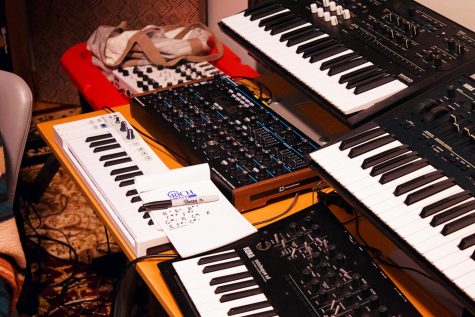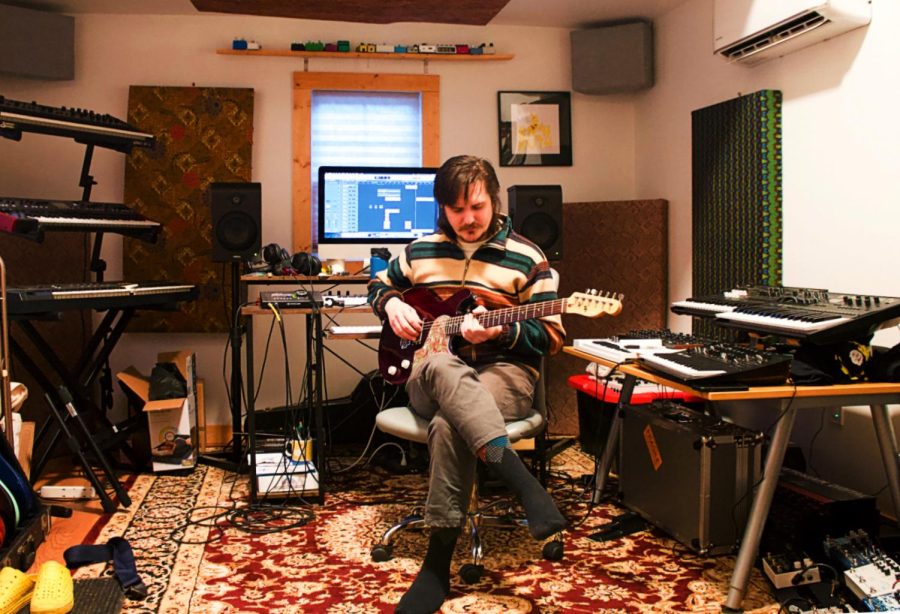Michael Ruth, known within musical circles as Rich Ruth, strolls onto the front lawn of his East Nashville home, holding a singular Lucky Strike cigarette and a blue pack of matches, perhaps stolen from a nearby restaurant or bar. He’s wearing an eclectic adornment consisting of a vintage blanket-lined jacket, a bootleg t-shirt of Bart Simpson posing as a Deadhead, brown pants and a strange mules-Crocs combination. The sky is filled with shades of gray and black. He stands next to me, lights the cigarette and begins discussing the endless enigma of the city he lives in.
“At times, it feels like a different place,” he laments; as the smoke blows past us and into the wind. “When we first moved down here, it was affordable, and the music scene was booming. I got a house with my band and we were able to write and record and rehearse in the same space. Logistically, Nashville made sense, too. You’ve got a ton of cool stuff popping up and it’s centrally located for touring.”
Now, almost 20 years later, Ruth feels a resounding change in the cultural landscape of Nashville.
Chloe Stillwell’s examination of Nashville, written in 2021 for Slate, remains infallible to this day. Over the past few decades, she states that the city has become more right-leaning, tourist-based and class-divisive. According to the 2023 Vanderbilt Poll, Nashvillians have lost faith in their government and their city, as outlooks become increasingly negative on both fronts. On every street corner, you see new developments and construction, and every week, another controversy graces the floor of the Tennessee legislature. Vanderbilt has contributed much to the changing landscape of Nashville, primarily through its redesign of the West End neighborhood. Rapid growth has led to AirBnbs en masse, pushing locals to the outskirts of the city, whether that be Ruth’s residence in East Nashville or farther beyond city limits.
Even in the music scene, reverent institutions are coming closer to turning the lights out for good. In the Gulch, the corpse of the Mercy Lounge sits closed and the Station Inn becomes landlocked as hotels and BBQ restaurants take over the surrounding space. Closer to Vanderbilt’s campus, the venerated Elliston Place venue Exit-In hovers between survival and a slow death, as new developments cast long shadows at its door.
“That era began fading away, but there’s always gonna be a good core of musicians and writers, and that’s why I’ve stayed,” Ruth said.
He specifically points out the loss of Arnold’s Country Kitchen, saying he went to the venerated meat-and-three five times in the last week it was open.
“They went out on their own terms, though, which I respect. And, supposedly, they’re gonna reopen. I hope,” Ruth said.
Although now considered a local, Ruth was once a transplant — moving from a small college town in Indiana to Music City over a decade ago in 2011 to improve his footing in the music community.
His musical roots date back to his childhood, though; spending his early years in a small town in Ohio. His mom “forced” him to be in a choir and take up piano, but it first clicked when he got a guitar at age 13. His cousin gave him lessons, and, from there, he went to college and started a band with his friends, who called themselves the Kansas Bible Company.
“It taught me a lot on how to work with people,” Ruth says of his time with the indie-folk outlet. “It was idealistic, and we were democratic, but there were too many people. Now, at the end of the day, I’m in control. People can still express themselves fully, and I want them to, but I can communicate my vision and sculpt it into something meaningful.”
An unassuming white tour bus sits on the side of the Ruth household — the type typically reserved for youth groups or carpet cleaning companies. Yet, it just made a trip to the West Coast, opening for California jam band Circles Around the Sun, and he’s about to go on the road as a part of SG Goodman’s backing band.
Ruth and I walk to the rear of the house, sliding past the bus and opening the latch into the backyard. Around back, next to a small fire pit and a grassy patch, is a small shed: his home studio. As we walk in, he tells me that a shoegaze band called Narrow Head stayed here last night — a couch sits in the corner of the room, and a lofted area above holds a queen bed. Inside the studio is a precarious blend of clutter and organization — guitars and synths adorn the room systematically, along with notepads outlining song ideas and rudimentary sketches. In the rear of his studio, an iMac runs Logic Pro X.

He opens his computer to show me a song, likely off his forthcoming EP. We’re greeted by the raging sounds of death metal — a genre he’s been digging into lately.
“Shit, I don’t even know why that’s playing right now,” he mutters amidst laughter.
Technology wasn’t his friend today, I thought, as his computer took a mind-numbingly long time to boot up his software. While this happens, a ping-pong match of artists emerges in our conversations — Jerry Garcia, Bill Frisell, Frank Zappa, Brian Eno, Robert Fripp and CAN, to name a few. They’re all Ruth’s influences, which sometimes feels like a grab bag of artists across genres and generations. He also tells me about the times he’s met his heroes – whether it’s partying with Grace Jones in a Norwegian hotel room or visiting with Ira Kaplan at a small-town festival in Nelsonville, Ohio.
Eventually, the software loads, and we land on a song titled “New Ambient Work 6 PART 3,” though he has not given it an official name yet. He clicks play, and the parts immediately begin to weave in and out of each other. The file holds 51 tracks of instruments and various field recordings collected over almost a year — including a clip of train passengers in an unidentified European country.
“Every day, I’ll come back up and think, ‘What do I need to add?’ or in this case, ‘What do I need to take away, you know.”
In one musical break, Ruth jams with an Indian classical musician who plays the tabla — a set of hand drums used in classical music for over 300 years. He recounts a time when he stayed in a guest house in Jaipur, where the owner introduced him to his friends who were trained in Indian classical music.
“We just passed around a guitar,” Ruth said. “This guy was doing this technical, mesmerizing stuff on a water jug. We kept in touch, and, eventually, I got him to record parts for some songs.”
He mainly works in short bursts, akin to his touring schedule.
“Being busy and being on the road gives me meaning, and that translates into my music,” Ruth said.
Ruth also looks to Khmer, ambient music, spiritual jazz, and Krautrock as inspiration for his next record.
I’m looking to combine disparate sonic elements,” he said, “The hope is that the sum of these parts create a specific mood I’m looking for.”
Scanning the room, the walls of Ruth’s studio are adorned with various objects that some may consider art. Christmas lights of the Dancing Bears hang over the door. A friend’s drawing of Bart Simpson hangs in the corner. A collection of vibrant, prismatic tapestries adorns the walls. And, right next to his guitars, two modest paintings of a barn quilt hang. These two works, created by his wife, were the basis for his latest album’s artwork, entitled “I Survived, It’s Over.” The phrase is a mantra for Ruth, which he’s developed with his therapist over the past couple of years.
Trauma stemming from an armed carjacking has rippled through his life, leading to his family moving homes and what he detects to be a “darker theme” in his music.
“It really affected me,” Ruth said. “This album represents a culmination of that time — the pandemic, political mayhem and my own struggles and perseverance. I can’t separate all of that stuff from the music and what it means to me.”
The album opens with “Taken Back,” where a light ambient buzzing enters before drums and a blaring guitar penetrate your senses. The music fills your brain with a barrage of sounds — a mix of simplistic horn breaks and complex guitar parts. The other eight songs on the record follow a similar structure: weaving musical textures into a discontinuous format. This erratic nature, however, creates an unexpected calming effect on the listener: one where the music washes over you and transports you to an enigmatic dream state. The longest song on the record, “Thou Mayest,” combines these disparate elements into a heady sonic environment. The listener floats in and out of field recordings, TV static and the sermon of a televangelist, all whilst the underpinnings of his influences remain. One can detect pedal steel, perhaps influenced by his love for the instrument and the “Rainforest Drums” that adorn late-80s Dead tapes.
Mixed by John McEntire, who previously worked with Stereolab, Tortoise and Yo La Tengo, Ruth’s vision of intricate and encyclopedic music remains intact. The album is Ruth’s second for Third Man Records, owned by Jack White. The musical relationship first grew from a friendship with Ben Swank, co-owner of the Detroit/Nashville/London-based record label.
“They were the most natural option,” Ruth said. “It’s a great environment with good people and good taste.”

Ruth’s guitar setup is always changing — his studio is full of Music Masters, Telecasters, Sonex’s and a modded-out Stratocaster reminiscent of Jerry Garcia’s Alligator setup. However, Ruth’s main guitar reflects a more timely figure. His J Mascis Jazzmaster, popularized by Dinosaur Jr’s lead guitarist, is a mainstay within his arsenal with its instantly recognizable white body and contrasting gold pickguard. Despite its $400 price tag, the Squier guitar feels hefty and packs a punch. The offset guitar has found its way from the stage of S.G. Goodman’s Americana band into most of his ambient recordings.
Despite fond memories of his previous band Kansas Bible Company, Ruth notes that he finds himself at the precipice of a distinct change in the record industry.
“You know, the band model just isn’t as sustainable as it used to be. The ecosystem is a lot different: it’s a lot easier to record yourself in studios, and you can still have that freedom of working with others and by yourself. It seems a lot of people are shifting to solo artists, and I’m one of those people.”
With these major fluctuations in the music industry and Music City, Ruth hasn’t lost sight of the fulfillment that making music brings.
“It’s always morphing; it’s easy to be cynical, but at the end of the day, good music will surface,” Ruth says.









